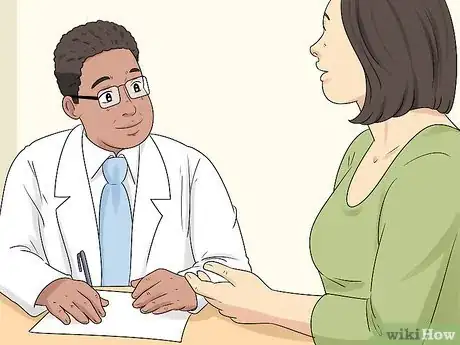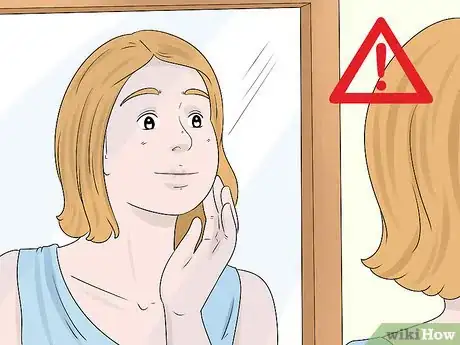This article was co-authored by Kristi Acuna. Kristi Acuna is a Holistic Nutritionist and the Owner of Holistic Nutrition Center in Orange County, California. With over 15 years of experience, Kristi specializes in a comprehensive and holistic approach to nutrition through nutrition response testing, heart rate variability, thermography, and brainspan. She has experience helping with weight gain, fatigue, insomnia, food allergies, diabetes, irritable bowel syndrome, digestion problems, sinus infections, and PMS and menopause symptoms. Kristi holds a BS in Holistic Nutrition from Clayton College of Natural Health. Holistic Nutrition Center focuses on the root cause of health challenges and helps people heal and restore balance to their bodies.
There are 10 references cited in this article, which can be found at the bottom of the page.
This article has been viewed 97,486 times.
If you suspect your iron levels aren't what they should be, your best course of action is to head to the doctor, where they can test your iron levels. If you can't afford that option, try giving blood. While the technicians won't give you an exact iron level, they do test your hemoglobin levels with a fingerstick. They perform this test to weed out donors whose iron levels are too low or too high. Also, watch for the symptoms of low and high iron to know when to visit your doctor.
Steps
Going to the Doctor
-
1See your doctor if you suspect your iron levels are low. Your doctor is the best way to get your iron levels checked. Make an appointment to see your doctor within 1-2 weeks if you're showing basic signs of anemia like fatigue. The first step the doctor will take is to ask you about any history you've had with low iron in the past. Then, the doctor will ask you questions about your recent symptoms and health.[1]
- If you are having heart palpitations or shortness of breath, go immediately to urgent care or the emergency room. If you're having chest pains and breathing problems together, go straight to the emergency room.
- Your doctor may ask you about your diet. For women, they may also ask if you've had a heavy period recently.
- It can help to write down any symptoms you've been experiencing before you head to the doctor. That way, you won't forget when you get to the exam room.
-
2Expect a physical exam. The doctor will do things like look at your mouth, skin, and nail beds, listen to your heart and lungs, and feel your abdominal area. They will be checking for signs of low or high iron.[2]
- Some signs of low iron may include fatigue, shortness of breath, dizziness, coldness in your extremities, pale skin, slowed appetite, and cravings for non-food items (known as pica). Let your doctor know if you have experienced any of these.[3]
- Other physical signs your doctor may look for include brittle nails, a swollen tongue, cracks in the sides of the mouth, and frequent infections.
Advertisement -
3Be ready for a blood test. The doctor will order blood tests if they suspect your iron levels aren't right.[4] The doctor may use more than one type of blood test to check to see whether your iron levels are high or low.[5] Usually, you'll get results between 1-3 days after you had the blood test.
- These tests will give your doctor an idea of your hemoglobin levels. These levels measure how much oxygen is binding with your red blood cells.
- Your doctor might also recommend a nutrition response test to see if your body needs iron.[6]
Checking Your Iron Levels while Giving Blood
-
1Find a place where you can donate blood. Check the websites of blood donation organizations to find out where you can donate. For instance, you can use the American Red Cross website to look for blood donation centers in your area. Alternatively, watch for blood drives where you can give blood.
- The American Red Cross states that it administers the hemoglobin test on its website. Check to make sure the organization you're donating with also provides this test. Most organizations screen for low or high iron levels.
-
2Go in to donate blood. This method requires that you be willing to donate blood, as the test is part of the donation process. Usually, you can just show up to donate--you don't need to make an appointment. However, you do need to be healthy. You also need to be at least 17-years-old and weigh a minimum of 110 pounds.[7]
- For donating blood, "healthy" means you are able to perform your usual routine, and you have any chronic disease, such as diabetes, under control. It also means that you don't have an infection like a cold or the flu, or certain illnesses including malaria, syphilis, and HIV/AIDS.
-
3Expect a finger prick. Before you give blood, the technician will stick your finger using a fingerstick, which just means they poke your finger with a small, spring-loaded needle. That will produce a drop of blood the technician can use to check your hemoglobin levels.[8]
-
4Ask about your hemoglobin level. The technician likely won't give you an exact figure. However, this test is used to screen you for high or low hemoglobin, which can indicate high and low iron. Therefore, if you're disqualified from giving blood, you can ask if it was your hemoglobin level and whether the level was in the high or low range.[9]
- The technician is looking for certain levels of hemoglobin in your blood, but they will likely just have a general range to see if you fall above or below certain levels. They'll disqualify you if you fall in these ranges.
- For instance, if your hemoglobin levels fall below 12.5 g/dL for a woman or 13 g/dL for a man, you can't give blood because your iron levels are likely too low.
- If your levels are above 20 g/dL for a man or woman, you can't give blood because your iron levels are likely too high. This is a rare occurrence.
Looking for Signs of Low or High Iron
-
1Notice fatigue or weakness if you suspect low iron levels. Fatigue is one of the primary signs of low iron levels. Iron is essential to your red blood cells, and your red blood cells carry oxygen throughout your body. When your red blood cells are low, your body isn't getting as much oxygen as it's accustomed to, which can make you feel very tired and weak.[10]
- Generally, this symptom is more than feeling a little tired for a day or two. It's a deeper tiredness that lasts over time.
-
2Pay attention to shortness of breath or dizziness for low iron. Because your body isn't getting enough oxygen, you may feel dizzy or lightheaded due to lack of oxygen. This can, in extreme circumstances, lead to issues with breathing, such as feeling like you can't take a deep breath. Such symptoms are rare, and typically associated with situations where someone is actively losing blood.[11]
- You may also notice headaches, which are a related symptom.
-
3Check for coldness in your extremities for low iron. With low iron levels, your heart is having to work harder to pump blood to your body because it doesn't have as many cells to carry oxygen. Therefore, your fingers and toes may feel colder than normal.[12]
-
4Look in the mirror for pale skin, a symptom of low iron. With your heart not pumping as efficiently, you may end up with pale skin. You may also notice this symptom in your nail beds and your gums.[13]
-
5Be vigilant about heart problems with low iron. Because your heart is working harder to move blood through your body, you can end up with heart problems. For instance, you may have a heart arrhythmia or murmur, which can feel like your heart is skipping a beat.[14]
-
6Notice if you get odd cravings for non-food items for low iron. Your body knows it's deficient in a needed nutrient, iron, and it may come up with odd cravings for things that aren't food. For instance, you may crave dirt, ice, or starch.[15]
-
7Watch for stomach issues, as they could indicate high iron levels. The main symptoms of high iron have to do with your stomach. You may experience constipation, vomiting, nausea, or stomach pain, all of which could indicate high iron levels.[16]
- Stomach issues can be a sign of many diseases, so don't automatically assume these issues are from high iron.
Expert Q&A
Did you know you can get expert answers for this article?
Unlock expert answers by supporting wikiHow
-
QuestionHow can you check your iron levels?
 Kristi AcunaKristi Acuna is a Holistic Nutritionist and the Owner of Holistic Nutrition Center in Orange County, California. With over 15 years of experience, Kristi specializes in a comprehensive and holistic approach to nutrition through nutrition response testing, heart rate variability, thermography, and brainspan. She has experience helping with weight gain, fatigue, insomnia, food allergies, diabetes, irritable bowel syndrome, digestion problems, sinus infections, and PMS and menopause symptoms. Kristi holds a BS in Holistic Nutrition from Clayton College of Natural Health. Holistic Nutrition Center focuses on the root cause of health challenges and helps people heal and restore balance to their bodies.
Kristi AcunaKristi Acuna is a Holistic Nutritionist and the Owner of Holistic Nutrition Center in Orange County, California. With over 15 years of experience, Kristi specializes in a comprehensive and holistic approach to nutrition through nutrition response testing, heart rate variability, thermography, and brainspan. She has experience helping with weight gain, fatigue, insomnia, food allergies, diabetes, irritable bowel syndrome, digestion problems, sinus infections, and PMS and menopause symptoms. Kristi holds a BS in Holistic Nutrition from Clayton College of Natural Health. Holistic Nutrition Center focuses on the root cause of health challenges and helps people heal and restore balance to their bodies.
Holistic Nutritionist
Warnings
- If you notice symptoms of high or low iron, visit your doctor for a blood test.⧼thumbs_response⧽
- Always talk to your doctor before starting or stopping a supplement like iron. They can advise you about whether you need to take it all, whether it's safe, and the proper dosage to take.⧼thumbs_response⧽
References
- ↑ https://www.nhlbi.nih.gov/health-topics/iron-deficiency-anemia
- ↑ https://www.nhlbi.nih.gov/health-topics/iron-deficiency-anemia
- ↑ https://www.nhlbi.nih.gov/health-topics/iron-deficiency-anemia
- ↑ Kristi Acuna. Holistic Nutritionist. Expert Interview. 17 September 2020.
- ↑ https://www.mayoclinic.org/diseases-conditions/iron-deficiency-anemia/diagnosis-treatment/drc-20355040
- ↑ Kristi Acuna. Holistic Nutritionist. Expert Interview. 17 September 2020.
- ↑ https://www.redcrossblood.org/donating-blood/eligibility-requirements
- ↑ https://www.redcrossblood.org/learn-about-blood/iron-and-blood-donation/iron-info-all-donors
- ↑ https://www.redcrossblood.org/learn-about-blood/iron-and-blood-donation/iron-info-all-donors
- ↑ https://www.nhlbi.nih.gov/health-topics/iron-deficiency-anemia
- ↑ https://www.mayoclinic.org/diseases-conditions/iron-deficiency-anemia/symptoms-causes/syc-20355034
- ↑ https://www.mayoclinic.org/diseases-conditions/iron-deficiency-anemia/symptoms-causes/syc-20355034
- ↑ https://www.nhlbi.nih.gov/health-topics/iron-deficiency-anemia
- ↑ https://www.nhlbi.nih.gov/health-topics/iron-deficiency-anemia
- ↑ https://www.nhlbi.nih.gov/health-topics/iron-deficiency-anemia
- ↑ https://www.nhs.uk/conditions/vitamins-and-minerals/iron/#what-happens-if-i-take-too-much-iron






































































Medical Disclaimer
The content of this article is not intended to be a substitute for professional medical advice, examination, diagnosis, or treatment. You should always contact your doctor or other qualified healthcare professional before starting, changing, or stopping any kind of health treatment.
Read More...